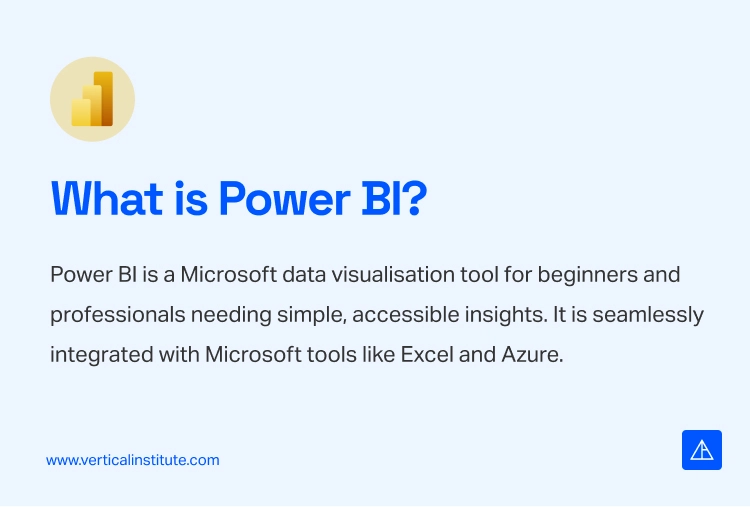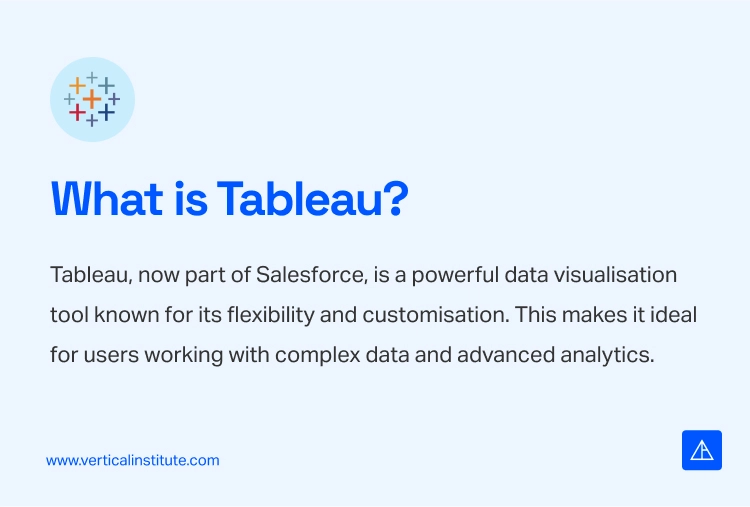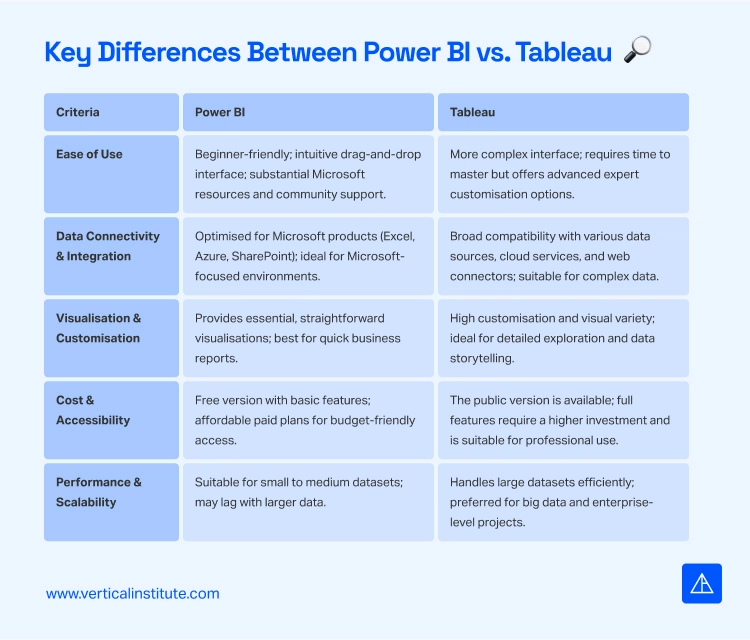Power BI vs Tableau: What is the Best Data Visualisation Tool to Learn
This article will explore the key differences between Power BI and Tableau, two leading data visualisation tools. You’ll learn which tool best suits different needs, from beginner-friendly features to advanced customisation, helping you make an informed choice for your data visualisation journey.
by Vertical Institute • 20 November 2024 • minutes read
In a world that thrives on data, decision-making has transformed into a data-driven process where businesses, teams, and individuals rely on data insights to guide strategies and achieve their objectives. The skills to interpret and visualise data effectively are becoming indispensable for aspiring professionals. Here, tools like Power BI and Tableau play a crucial role, offering powerful platforms to turn raw data into visually compelling insights that inform decisions.
This article provides an overview of the fundamentals of data visualisation and compares two popular tools, Power BI vs. Tableau, to help you identify the best fit for your journey.
What is Data Visualisation
Some key benefits of data visualisation include:
- Simplified Data Interpretation: Complex data becomes easier to understand.
- Enhanced Decision-Making: Clear visuals help decision-makers grasp insights quickly.
- Improved Communication: Visualisations make it easier to share findings across teams, ensuring everyone is aligned.
With data visualisation tools like Power BI and Tableau, even non-technical users can create meaningful visuals, opening data-driven decision-making to a broader audience.
What is Power BI?

Developed by Microsoft, Power BI is an accessible, business-focused data visualisation tool known for its user-friendly interface. Built with a deep focus on integration within the Microsoft ecosystem, Power BI is particularly popular among users familiar with Excel or Azure. It combines data connectivity, modelling, and visualisation with a focus on simplicity, making it ideal for beginners and professionals working with smaller datasets.
Key Features of Power BI
- Integration with Microsoft Suite: Seamlessly connects with Excel, SharePoint, and Azure.
- Intuitive Interface: Drag-and-drop functionality makes it beginner-friendly.
- Extensive Data Connectivity: Supports various sources, including SQL databases, Excel files, and cloud services.
- Cost-Effective Plans: Includes a free version and affordable premium options, making it budget-friendly.
What is Tableau?

Key Features of Tableau:
- Advanced Visualisation Capabilities: Offers more customisation options and complex visualisations.
- High Performance with Large Data Sets: Designed to handle big data efficiently.
- Flexible Data Connections: Supports various data sources and databases, including Salesforce and Google Analytics.
- Focus on Data Storytelling: Allows users to create interactive, presentation-ready dashboards.
Related: 5 Beginner-Friendly Tableau Projects For Your Portfolio
Key Differences Between Power BI vs. Tableau
Power BI and Tableau each bring unique strengths to data visualisation, catering to different user needs. Power BI is ideal for beginners, those working within the Microsoft ecosystem, and those looking for an affordable, straightforward tool. Conversely, Tableau is well-suited for advanced users who require extensive customisation options and need to handle large data sets efficiently.
Here’s a look at the key differences between Power BI and Tableau:

Choosing Between Power BI and Tableau: Which Tool is Right for You?
- Are familiar with Microsoft tools like Excel and Azure.
- Work primarily with small to medium-sized datasets.
- Prefer an affordable, easy-to-use tool.
- Need basic to intermediate data visualisation capabilities.
For those seeking advanced data capabilities, Tableau provides powerful features tailored to complex analysis. Tableau is ideal for users who:
- Designed for handling large or complex datasets.
- Offers high-quality, highly customisable visuals.
- Supports advanced data storytelling and presentation needs.
- Ideal for industries where deep data exploration is essential.
Related: 5 Study Strategies That Will Help You Ace the Tableau Certification
Conclusion
Power BI and Tableau each bring unique strengths to data visualisation and decision-making. Power BI offers a budget-friendly, beginner-friendly entry point, while Tableau provides advanced customisation for handling larger datasets. Both tools enhance data insights by making complex information visually accessible, improving team decision-making. By equipping users with skills to turn data into clear, actionable insights, these tools are invaluable for today’s data-driven professionals.
Level Up Your Skills with Vertical Institute’s Free Expert Workshops!
Unlock new skills and accelerate your career through our expert-led sessions. Our free workshop covers in-demand tech fields like data science, data analytics, digital marketing, cybersecurity, and more—providing you with hands-on experience and certifications that employers value. Whether you’re starting fresh or looking to advance, our workshops equip you with practical knowledge to stay competitive in today’s digital landscape.
Explore our upcoming events and book your spot today to take the next step in your professional journey!
FREE WORKSHOPS
Explore our free workshops and uncover the skills you need to succeed.
About Vertical Institute
Vertical Institute is shaping the future of work by preparing individuals for tomorrow’s job market. Our courses and certification focus on teaching essential skills and nurturing the next generation of innovators and leaders.
As an Approved Training provider (ATO) accredited by SkillsFuture Singapore (SSG) and the Institute of Banking & Finance Singapore (IBF), our courses adhere to the highest standards. They are government-subsidised and eligible for SkillsFuture Credits or NTUC UTAP Funding.